Abstract
Background/Objective: Finding new targets to attenuate Mycobacterium tuberculosis (Mtb) is key in the development of new TB vaccines. In this context, plasma membrane P-type ATPases are relevant for mycobacterial homeostasis and virulence. In this work, we investigate the role of the copper-transporting P-type ATPase CtpA in Mtb virulence. Methods: The impact of CtpA deletion on Mtb’s capacity to overcome redox stress and proliferate in mouse alveolar macrophages (MH-S) was evaluated, as well as its effect on Mtb immunogenicity. Moreover, the influence of CtpA on the pathogenicity of Mtb in a mouse (BALB/c) model of progressive TB was examined. Results: We found that MH-S cells infected with wild-type (MtbH37Rv) or the mutant strain (MtbH37RvΔctpA) showed no difference in Mtb bacterial load. However, the same macrophages under copper activation (50 µM CuSO4) showed impaired replication of the mutant strain. Furthermore, the mutant MtbΔctpA strain showed an inability to control reactive oxygen species (ROS) induced by PMA addition during MH-S infection. These results, together with the high expression of the Nox2 mRNA observed in MH-S cells infected with the Mtb∆ctpA strain at 3 and 6 days post-infection, suggest a potential role for CtpA in overcoming redox stress under infection conditions. In addition, MtbΔctpA-infected BALB/c mice survived longer with significantly lower lung bacterial loads and tissue damage in their lungs than MtbH37Rv-infected mice. Conclusions: This suggests that CtpA is involved in Mtb virulence and that it may be a target for attenuation.
1. Introduction
Tuberculosis (TB) is a public health issue and the leading cause of mortality produced by a single infectious pathogen, known as Mycobacterium tuberculosis (Mtb) [1]. In 2023, there were 10.8 million new cases and 1.25 million deaths caused by TB [1]. The incidence of TB is primarily attributed to high rates of chemotherapy abandonment associated with the toxicity of certain anti-TB drugs, the emergence of multi- and extensively drug-resistant (MDR and XDR) Mtb strains, and co-infection with HIV [2,3]. Unfortunately, the Bacillus Calmette-Guérin (BCG), the only licensed vaccine against TB, demonstrates variable efficacy depending on the age and origin of the immunized population. Specifically, the BCG vaccine is effective in protecting pediatric populations from severe forms of TB; however, its efficacy against pulmonary TB (the main form of the disease) in adolescents and adults is variable [4,5]. Therefore, new strategies to control TB and the development of effective vaccine candidates against all forms of TB are pivotal.
To date, there are sixteen anti-TB vaccine candidates, five of which are currently undergoing Phase III clinical trials. However, thus far, none of the vaccines have demonstrated sufficient capacity to prevent or eradicate TB [1,6,7,8,9]. Among the anti-TB vaccine candidates, those based on live attenuated mycobacteria are of particular interest due to their capacity to display a broad antigenic repertoire and maintain the full complement of T cell epitopes that elicit an effective immune response [10,11].
It is therefore imperative to identify alternative Mtb attenuation targets and gain a deeper understanding of the molecular mechanisms that enable Mtb to evade macrophages during the infection process and facilitate the development of new TB vaccine candidates [12]. In this sense, membrane proteins are interesting targets for the rational design of anti-TB vaccines, given their pivotal function as transporters and mediators in the pathogen–environment interaction [13]. Several studies have demonstrated the importance of the P-type ATPase plasma membrane transporters for maintaining ionic homeostasis within cells and for the survival of Mtb [14,15,16,17,18,19,20].
Mtb encodes 12 open reading frames encoding P-type ATPases, classified according to ion specificity and transmembrane topology. Three copper transporters have been identified: CtpA, CtpB, and CtpV. These play an important role in mycobacterial heavy metal homeostasis by transporting cations across the plasma membrane against a concentration gradient [14,21,22].
Some studies have demonstrated that alterations in copper concentrations within the phagosome serve as an antimicrobial mechanism against intracellular pathogens, such as Mtb [23,24,25,26]. Moreover, the existence of multiple copper-transporting P-type ATPases within the mycobacteria indicates the potential for diverse physiological functions, including the regulation of cytoplasmic metal levels (detoxification) and the metalation of membrane/periplasmic cuproenzymes (alternative role) [15,16,20,23,27,28,29].
Prior research has indicated that P1B-type ATPases (heavy metal transporters) of Mtb with alternative functions, in contrast to their homologous counterparts (metal detoxification), may be essential for survival in the harsh environmental conditions of the phagosome and for the persistence of Mtb in vivo infection models [20,28].
Among the three Mtb copper-transporting P-type ATPases, only CtpV has been demonstrated to be essential for the detoxification of bacilli from copper [30,31]. The expression of ctpV is stimulated by high concentrations of copper and is controlled by cso, a copper-sensitive operon of Mtb [30]. MtbΔctpV mutant cells are unable to tolerate toxic doses of copper. Furthermore, the absence of ctpV has been demonstrated to result in elevated intracellular copper levels [30,31]. However, the deletion of ctpV in Mtb did not result in a significant reduction in colonization levels in a murine model [31].
Our research group has been interested in the relationship between bacterial copper response and the virulence of Mtb. This research has led to the characterization and study of CtpB and CtpA ATPases expressions under stress conditions that mimic the intra-phagosomal environment [22]. Our initial findings demonstrated that CtpB and CtpA are involved in the pumping of copper (I) from mycobacterial cells [14,15]. Furthermore, the disruption of ctpB in Mtb did not result in the susceptibility of MtbΔctpB cells to toxic doses of copper, nor did it lead to the accumulation of intracellular copper in cells cultured under high concentrations of copper. These findings suggest that CtpB is not directly associated with copper detoxification, but rather, it could play an alternative role in copper transport [15].
On the other hand, the expression of ctpA was observed to increase during infection, indicating that the function of this copper transporter is essential for the virulence of Mtb [19,32]. Additionally, ctpA is induced in low Cu2+ concentrations and under oxidative and nitrosative conditions in vitro. However, this upregulation was not observed in high concentrations of Cu2+ [16,21]. Furthermore, it is notable that the growth rate of the wild-type and ctpA mutant strain (Mtb∆ctpA) was comparable at both low and high doses of Cu2+. Additionally, disruption of ctpA did not result in intracellular copper accumulation, indicating that copper-mediated transport by CtpA may have an alternative function [16,21]. However, the Mtb∆ctpA strain exhibited a diminished capacity for growth when exposed to oxidative and nitrosative stress in vitro. To this end, we sought to determine whether a possible correlation exists between Cu(I) transport mediated by CtpA and the activity of MmcO, which, in turn, mediates the in vitro oxidative capacity of the phenolic compounds ABTS and pPD in lysates of mycobacterial strains [33,34]. This investigation revealed that whole-cell lysates of the Mtb∆ctpA strain, previously stimulated with Cu2+, H2O2, and sodium nitroprusside, exhibited a diminished capacity to oxidize organic substrates. These findings suggest that the efflux of copper transported by CtpA plays a crucial role in overcoming redox stress and may be essential for metalation and activity of MmcO in Mtb [16]. However, further investigation is required to determine the extent to which CtpA contributes to the virulence of Mtb.
In this context, the present study observed that a deletion of ctpA affects intracellular Mtb replication in alveolar macrophages (MH-S) under copper activation during the assay. Furthermore, a comparative analysis of BALB/c mice infected with the MtbΔctpA strain revealed that these animals exhibited prolonged survival times, a reduced bacillary load, and a lower percentage of pneumonia in comparison to animals infected with the parental MtbH37Rv strain. These findings collectively indicate that CtpA plays a pivotal role in the survival and virulence of Mtb. Consequently, this plasma membrane transporter may be regarded as a prospective target for attenuation in the development of a new TB vaccine.
2. Materials and Methods
2.1. Bacterial Strains and Growth Conditions
Bacterial strains used in this study are shown in Table S1. The ctpA mutant strain of MtbH37Rv was obtained using the recombineering technique with the Chec9c system, which promoted the allelic exchange between ctpA in bacterial DNA and the encoding gene for antibiotic resistance in the allelic exchange substrate (AES) [35]. The AES of ctpA [16] was cloned in the recombineering strain MtbH37Rv:pJV53 [11], and colonies with defective ctpA (MtbΔctpA) were selected for hygromycin (Hyg) resistance on 7H10 plates.
Mtb strains were cultured in Middlebrook 7H9 broth (Catalog 271310, BD Biosciences, Wokingham, Berkshire, UK) with supplements (10% OADC, 0.5% glycerol, and 0.05% tyloxapol (Sigma-Aldrich, St. Louis, MO, USA) at 35 °C with gentle agitation (70 rpm) until reaching mid-log phase measured at 600 nm (1.0–1.3), or on Middlebrook 7H10 and 7H11 agar (Catalog 262710 and 212203, respectively, BD Biosciences, Wokingham, Berkshire, UK) supplemented with OADC and 0.5% glycerol.
Kinetics of mycobacterial growth were conducted according to the procedures reported previously by our laboratory [11]. Isolated colonies of MtbΔctpA and MtbH37Rv were cultured in 7H9 broth until reaching the stationary phase (OD600 ~ 2.0–2.5, for approximately 30 days). The OD600 of the mycobacterial cultures was then measured daily in a spectrophotometer (Thermo Scientific, Waltham, MA, USA) [11]. For the infection experiments (Figure 1), batches of the mycobacterial strains MtbH37Rv and MtbΔctpA were harvested during the mid-log phase, counted, aliquoted, and stored at −80 °C until use.
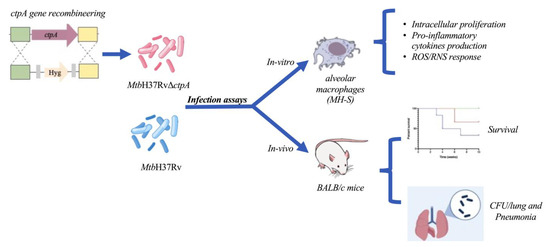
Figure 1.
Scheme of the experimental strategy. The deletion of ctpA in Mtb is evaluated in in vitro and in vivo infection models.
2.2. MH-S Cells Culture
Murine alveolar macrophage MH-S cell line (ATCC CRL-2019) was cultured in a 10 cm2 cell culture dish containing Roswell Park Memorial Institute Medium (RPMI) (GibcoTM, Waltham, MA, USA) with 2 mM l-glutamine, 10 mM HEPES, 2.0 g/L NaHCO3, pH 7.4) supplemented with 10% fetal bovine serum (FBS) (medium complete) and incubated at 37 °C in 5% CO2 atmosphere until reaching 80% confluence.
2.3. Infection of MH-S Cells with Mtb Strains
1 × 105 cells were co-cultured with Mtb strains at an MOI (Multiplicity of infection) of 1:4 and incubated for one hour at 37 °C and 5% CO2 to allow the infection. To remove extracellular bacteria, three washes with RPMI medium plus 1% penicillin and 1% streptomycin (GibcoTM, Waltham, MA, USA) were performed. Then, cells were carefully resuspended in 1 mL RPMI-10% SFB medium with or without CuSO4, and incubated for 1, 2, 3, or 6 days. At each time post-infection, the supernatants were harvested by centrifugation at 14,000 rpm for 10 min and stored at −80 °C until further analysis (for cytokine and nitric oxide determinations). The infected MH-S cells were lysed with 0.1% SDS and neutralized with 20% BSA in 7H9 broth. The viability of intracellular bacteria was determined by counting colony-forming units (CFU) through serial dilution method after 21 days of incubation at 37 °C in 5% CO2.
2.4. Cytokine Production in Mtb-Infected MH-S Cells
TNF-α, and IL-12 concentrations in infected MH-S cell culture supernatants were quantified using a sandwich ELISA with the BD OptEIATM Mouse IL-12 (p40) ELISA Set (Cat. No. 555165), and the BD OptEIATM Mouse TNF-α ELISA Set II (Cat. No. 558534). Assays were conducted in accordance with the manufacturer’s instructions and our laboratory specifications [11].
2.5. Determination of the Nitric Oxide (NO) Concentration Produced by Infected MH-S
The nitrite concentration was used as a measure of NO production [36]. To quantify the nitrite concentration, 50 μL of the previously supernatants collected was reacted with 150 μL of Griess reagent (0.2% N-(1-Naphthyl) ethylenediamine dihydrochloride, and 2% sulfanilamide in 5% phosphoric acid) for 30 min at 35 °C. Absorbance was measured at 540 nm. A calibration curve was prepared in parallel using NaNO2 (0–27.5 ng/μL) in triplicate in the 96-well plate, to which an equivalent volume of Griess reagent was added.
2.6. RNA Extraction and cDNA Synthesis from Mtb-Infected Cells
RNA was extracted from MH-S macrophages infected with mycobacteria using the Quick-Start Protocol RNAeasy® Mini Kit (Cat. No. 74104, Qiagen, Germantown, MD, USA) according to the manufacturer’s instructions. cDNA libraries were constructed with 0.5 μg RNA, 1 μL Oligo(dT)12–18, 1 μL dNTP mix, and RNase-free water, with the mouse leukemia virus reverse transcriptase (M-MLVRT, Cat. No. 28025013; Invitrogen™, Carlsbad, CA, USA). The concentration of cDNA and the Abs 260/280 ratio were determined using an Epoch Microplate Reader (Bio Tek Instruments, Inc., Winooski, VT, USA).
2.7. RT-qPCR in Mtb-Infected Macrophages
The transcription levels of mRNA encoding IL-1β, Nos2, and Nox2 were evaluated by RT-qPCR in MH-S cells infected with the mycobacterial strains. Quantitative PCR (qPCR) reactions with 100 ng of cDNA were measured using SsoAdvanced Universal SYBR® Green Supermix in a CFX-96 thermal cycler (Biorad, CA, USA). The specific details of the qPCR program and oligonucleotide sequences [37,38,39] are provided in Tables S2 and S3. Efficiency curves were constructed using cDNA serial dilutions (0.01–100 ng/μL) from uninfected MH-S macrophages (Figure S1). The relative transcription levels were calculated using the Pfaffl method [40], with glyceraldehyde-3-phosphate dehydrogenase (gapdh mRNA) as the reference gene. Each quantification was performed in triplicate, with a negative control reaction lacking cDNA.
2.8. Quantification of Reactive Oxygen Species (ROS) Produced in Mtb-Infected Macrophages
The concentration of ROS in MH-S macrophages infected with mycobacteria was determined using the NBT assay for measuring intracellular superoxide (O2•–) production [41,42]. 1.0 × 105 MH-S cells were seeded into 12-well dishes in RPMI-10%FBS. The cells were incubated at 37 °C and 5% CO2 for 48 h. Then, the cells were infected with Mtb strains (MOI 1:5) and incubated for an additional hour at 37 °C and 5.0% CO2; uninfected cells were included in the assay as a control for ROS production. Subsequently, the supernatants were removed, and each well was washed three times with 1X PBS and a 1% antibiotic solution. Subsequently, 300 μL of each of the solutions—Y-NBT (1 mg/mL), Y-NBT with PMA (900 ng/mL), and Y-NBT with PMA (900 ng/mL) and SOD (30 μg/mL), all prepared in DMEM/F-12 without phenol red (Gibco™ 21041025, Waltham, MA, USA)—were added separately to the wells in triplicate. The plates were incubated for 90 min at 37 °C with 5% CO2. The cells were washed three times with warm PBS, twice with methanol, and then air dried. The NBT reduction product was dissolved in 240 µL of KOH (2 M) and 280 µL of DMSO (100%), and the plates were incubated at 35 °C with shaking for 10 min. 100 µL of the supernatants (in quadruplicate) were transferred to a 96-well plate and the absorbances were determined at 620 nm in an Epoch microplate Reader (Bio Tek Instruments, Inc., Winooski, USA). To quantify the NBT dissolution, a calibration curve was prepared with NBT (0.312–20 nmol) in a solution of 1:1.2 (KOH:DMSO), as previously described by Rook et al. [42].
2.9. Progressive Pulmonary TB Model of BALB/c Mice
The animals used in the infection model were provided by the Department of Experimental Research and Animal Housing of the INCMNSZ. For the infection, aliquots of the different Mtb strains were thawed and sonicated for 45 s to prevent the formation of clumps formations. For each Mtb strain (MtbH37Rv, and MtbH37RvΔctpA), a total of 16 mice (8-week-old BALB/c mice with an average weight of 22 g) were assigned to each group. Mice were anesthetized with sevoflurane (Sigma-Aldrich, St. Louis, MO, USA) and infected endotracheally with 2.5 × 105 CFU in 100 μL of PBS [43]. Following infection, mice were housed in boxes with HEPA-filtered ventilation (Lab Products, model Super Mouse 1800™ AllerZone™ Micro-Isolator®, LabProducts Inc., Houston, TX, USA) with 12 h light-dark cycles. After animal infection, the remnant of the bacterial inoculum was plated to confirm the number of CFU administered to the animals. If, during the evolution of the experiment, animals exhibited poor mobility, piloerection, high respiratory frequency, or a weight loss > 20%, the humane endpoint criteria were applied.
On days 3, 21, 60, and 120 post-infection, groups of four mice were euthanized by exsanguination under anesthesia with sodium pentobarbital (Sigma-Aldrich, St. Louis, MO, USA) at a dose of 210 mg/kg. The right lungs were promptly frozen, and were stored at −80 °C until processing. To estimate the bacterial burdens, lungs were homogenized, and the bacillary loads were determined by counting CFU through serial dilution method after 21 days of incubation at 37 °C in 5% CO2. The left lungs were perfused with ethanol, fixed for 72 h, and embedded in paraffin for further histological analysis. Photomicrographs were taken at 25× on a Leica microscope and pneumonic areas were delineated and measured using the automated Leica Application Suite v4.0 software (LASv4.0), and the percentage of lung surface affected by pneumonia was calculated. Survival curves were constructed with the animals used in virulence kinetics using GraphPad Prism 9 (GraphPad Software, San Diego, CA, USA).
2.10. Statistical Analysis
All statistical analyses were performed using GraphPad Prism 9 Software. Data were analyzed using Student’s t-comparison test to evaluate the CFU/mL, RT-qPCR, ROS and cytokines concentration results between strains. Differences of p < 0.05 (*), p < 0.01 (**), p < 0.001 (***), and p < 0.0001 (****) were considered to be statistically significant.
3. Results
3.1. The ctpA Deletion Does Not Alter the Mtb Growth Kinetics in Standard Culture Conditions
Prior to conducting the infection assays, the growth curves of MtbH37RvΔctpA and MtbH37Rv under standard culture conditions were obtained (Figure 2). The time and OD600 corresponding to the mid-exponential growth phase were determined (Log1/2).
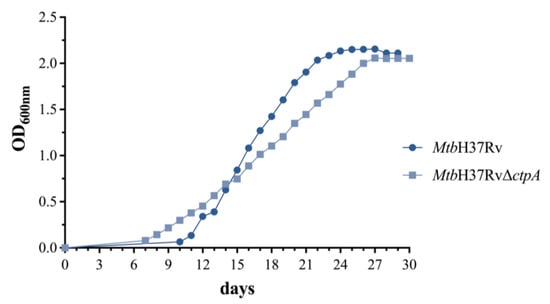
Figure 2.
Growth curve of MtbH37Rv and MtbH37RvΔctpA strains in standard cultures. Mtb strains were grown in 7H9-OADC-0.05% tyloxapol medium at 37 °C with shaking (70 rpm) in 5% CO2. OD600 was monitored until the culture reached the stationary phase. Curves represent the mean ± standard deviation of three technical replicates.
The mutant strain reached the Log1/2 phase at OD600 of 1.028, which is comparable to the previously reported value of 1.07 for MtbH37Rv under identical conditions [11]. Furthermore, as demonstrated in Figure 2, the MtbH37RvΔctpA strain exhibited a shorter latency phase in comparison with the parental strain. The replication rate of the mutant (0.105 OD600/day) in the log phase was found to be lower than the parental strain (0.192 OD600/day) [11]. This indicates that the ctpA gene is not indispensable for the growth rate of Mtb in standard laboratory culture conditions. However, it may exert an influence on the bacilli adaptability and replication rate.
3.2. ctpA Is Required for Intracellular Proliferation of Mtb in Copper-Activated Alveolar Macrophages
To ascertain whether, as with other P1B-type ATPases, CtpA may be involved in the intracellular survival of Mtb [20,28], the bacterial load (CFU/mL) was quantified at different post-infection times in mouse alveolar macrophages (MH-S cell line) infected with the wild-type MtbH37Rv or mutant MtbΔctpA strain at MOI 1:3 (Figure 3). Considering that CtpA is a Cu+-ATPase, it is possible that the bacterial growth could be affected by the presence of copper, which is required for the activation of CtpA [16]. To investigate this, the bacterial load was assessed with and without 50 μM CuSO4 (Figure 3).
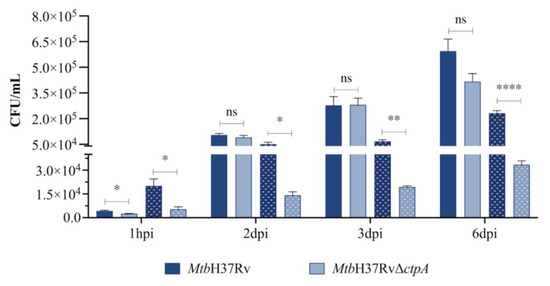
Figure 3.
Intracellular proliferation of MtbH37Rv and MtbΔctpA in alveolar macrophages. 1 × 105 macrophages (MH-S) were infected at a 1:3 MOI with Mtb strains in the absence (solid bar) or presence of 50 μM CuSO4 (dotted bar). Values correspond to the mean ± SEM of three technical replicates from two independent experiments. Asterisks indicate significance (two-tailed Student’s t-comparison unpaired test) at same culture condition (ns p > 0.05, * p < 0.05, ** p < 0.01, **** p < 0.0001).
As shown in Figure 3, at 1 h post-infection (hpi), which is the time period at which mycobacteria are predominantly phagocytosed [44,45], the mutant strain MtbΔctpA exhibited a diminished capacity to infect MH-S cells, in comparison to the parental strain, and independent of the presence of copper (p < 0.05). However, in the absence of copper during late infection, no differences were observed in the replication of the MtbΔctpA strain in comparison to the wild-type strain. The MtbH37Rv strain exhibited 138-fold increase (1 h and 6 dpi: 4300 and 594,286 CFU/mL, respectively) in colony-forming units (CFU) at the sixth day post-infection, while the mutant strain showed a 136-fold increase (1 h and 6 dpi: 2550 and 416,250 CFU/mL, respectively) in the same time period (Figure 3). In contrast, when the MH-S infection advanced in the presence of CuSO4 (50 μM), the MtbΔctpA mutant displayed impaired proliferation, resulting in a significantly reduced number of bacteria (CFU/mL) from one to six days post-infection compared with the control strain (Figure 3). The MtbH37Rv strain displayed a 11.5-fold increase in CFU during the 6 dpi period (with 50 μM CuSO4; 1 h and 6 dpi: 20,091 and 231,333 CFU/mL, respectively), whereas the MtbΔctpA strain exhibited a 6.22-fold increase at the same infection time (with 1 h and 6 dpi: 5,389 and 33,500 CFU/mL, respectively). These findings indicate that, as observed in other murine macrophage cell lines, copper enhances the bactericidal activity of alveolar macrophages of the MH-S line, thereby contributing to the control of Mtb infection [46,47]. These findings also indicate that ctpA is necessary for the optimal survival and intracellular multiplication of Mtb within MH-S macrophages in the presence of 50 μM CuSO4 (Figure 3). Therefore, it can be suggested that the intracellular proliferation of Mtb is impaired by ctpA deletion, which is probably due to the specific effect of macrophage activation by copper.
3.3. Copper Modulates the Proinflammatory Response of MtbΔctpA-Infected MH-S Cells
The objective of developing live attenuated vaccines against mycobacteria is to provide activation to the immune system similar to the natural infection, with minimal or no immunopathology [48]. Considering the low intracellular proliferation of MtbΔctpA mutant in MH-S cells, we assessed whether the ctpA deletion affects the production of proinflammatory cytokines during infection of mouse alveolar macrophages. Consequently, we quantified the relative expression of IL-1β mRNA, as well as the levels of interleukin-12 (IL-12) and TNF-α produced by MH-S cells infected with Mtb strains in the presence and absence of CuSO4 (Figure 4 and Figure 5).
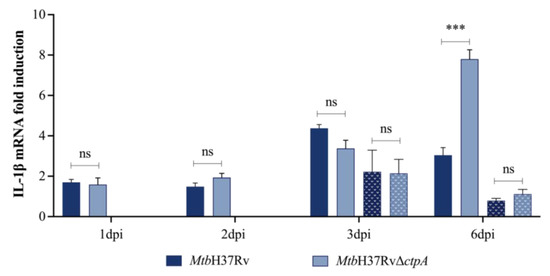
Figure 4.
Transcription of IL-1β mRNA in Mtb-infected macrophages. The levels of IL-1β mRNA produced by MH-S cells infected with MtbH37Rv or MtbH37RvΔctpA in the absence (solid bar) or presence of 50 μM CuSO4 (dotted bar) were quantified by RT-qPCR. Relative transcription levels were calculated using the Pfaffl method concerning uninfected cells using the gapdh gene as a housekeeping gene. Presented values correspond to the mean ± SEM of triplicate of four independent experiments. Asterisks indicate a statistically significant difference with respect to the transcription induced by parental strain infection (ns p > 0.5, *** p < 0.005).
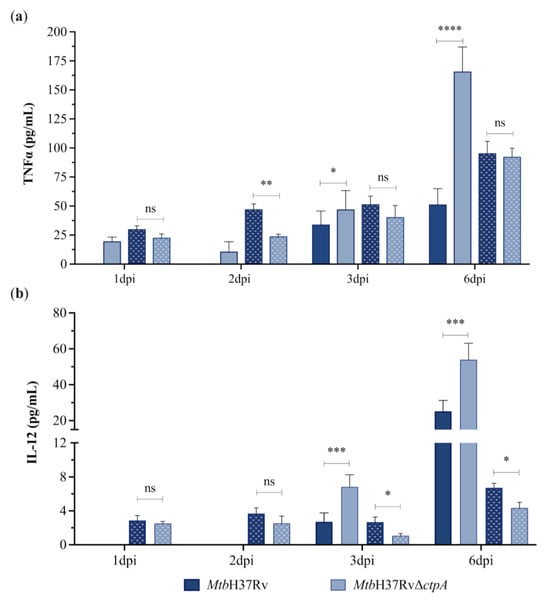
Figure 5.
Proinflammatory cytokine secretion by infected macrophages with Mtb strains. The levels of tumor necrosis factor (TNF-α) (a) and interleukin-12 (IL-12) (b) were determined in the supernatants of MH-S cells infected with MtbH37Rv or MtbH37RvΔctpA strains at an MOI of 1:3 in absence (solid bar) or presence of 50 μM CuSO4 (dotted bar). The plotted values represent the mean concentration (in pg/mL) ± SEM of each cytokine from three independent experiments. Asterisks indicate statistical significance (two-tailed unpaired t-test comparison, ns p > 0.05; * p < 0.05; ** p < 0.01;*** p <0.001; **** p < 0.0001). IL-12 values on days 1 and 2 dpi in the assay without copper are below the detection limit.
Gene expression analysis in MH-S cells shows that cells infected with the MtbΔctpA strain in the absence of CuSO4 exhibited a higher level of IL-1β transcription than cells infected with the wild-type strain at 6 dpi, which is not observed in the presence of the metal (Figure 4). Similarly, the MtbΔctpA strain induced statistically significantly higher levels of TNF-α and IL-12 than the control strain at 3 to 6 dpi, only in the absence of the metal (Figure 5). These findings suggest that, in the absence of copper ctpA, deletion affects the immunogenicity of Mtb in vitro; however, the infection of MH-S cells with MtbΔctpA induces the production of key protective cytokines that contribute to the control of bacilli growth by macrophages [49,50,51,52].
Furthermore, our findings suggest that CuSO4 (50 μM) may modulate the host proinflammatory response [53] of macrophages infected with the MtbΔctpA mutant strain. At 6 dpi, the presence of copper during the assay resulted in a significant reduction in IL-1β mRNA and proinflammatory cytokines (TNF-α and IL-12) produced in response to MtbΔctpA infection, as compared to the levels observed at the same period of infection in the absence of the metal. Conversely, in the presence of CuSO4, macrophages infected with the parental strain showed a less pronounced reduction in IL-1β mRNA gene expression and IL-12 production, and an increased level of TNF-α (Figure 4 and Figure 5) at 6 dpi.
3.4. MtbΔctpA Mutant Displays Impaired Ability to Control Reactive Oxygen Species (ROS) During Infection of MH-S Cells
In a previous report, we discussed the potential relevance of CtpA-mediated copper transport in the ability of the bacillus to cope with redox stress under in vitro conditions [16]. To evaluate whether the deletion of ctpA affects the redox stress exerted by macrophages under infection, the production of ROS (O2•−) and RNS (NO) was compared in MH-S cells infected with MtbH37Rv or MtbΔctpA. Additionally, the expression of the genes encoding key enzymes in the production of NO (iNOS, the Nos2 gene) and O2•− (NADPH oxidase, the Nox2 gene) was determined [54,55,56,57]. Activation of the Nox2 gene was higher (3.41-fold) at day 6 in MH-S cells infected with the mutant strain MtbΔctpA compared to cells infected with the wild strain MtbH37Rv (Figure 6a). Moreover, stimulation of macrophages with 50 μM CuSO4 resulted in activation of the Nox2 gene with the MtbΔctpA mutant strain from 3 dpi (Figure 6a). Conversely, transcription of the Nos2 (iNOS) mRNA and NO production exhibited a time-dependent induction in Mtb-infected macrophages (Figure 6b and Figure 7). However, there were no significant differences in NO production between cells infected with the wild-type or the mutant strain.
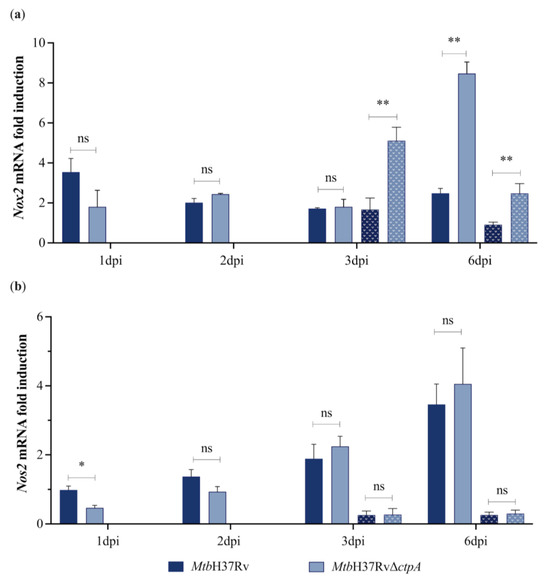
Figure 6.
Gene transcription of NADPH oxidase 2 and iNOS in Mtb-infected MH-S macrophages. The gene expression of Nox2 gene (a) and Nos2 (b) in alveolar macrophages infected with MtbH37Rv and MtbH37RvΔctpA at MOI 1:4 in the absence (solid bar) or presence of 50 μM CuSO4 (dotted bar) were quantified by RT-qPCR. Relative transcription levels were calculated using the Pfaffl method concerning uninfected cells using the gapdh gene as a house keeping gene. Presented values correspond to the mean ± SEM of the triplicate of four independent experiments. Asterisks indicate statistical significance (two-tailed unpaired t-test comparison, ns p > 0.05; * p < 0.05; ** p < 0.01).
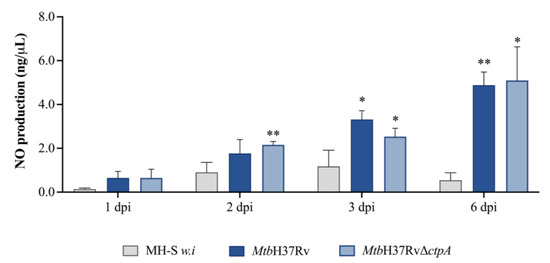
Figure 7.
Nitric oxide (NO) production in MH-S macrophages infected with Mtb. Quantification in supernatants of NO produced by 1x105 alveolar macrophages (MH-S) non-infected (w.i) or infected at 1:3 MOI with MtbH37Rv or MtbH37RvΔctpA was determined by Griess reagent as total nitrite measured at 540 nm [36], using a NaNO2 calibration curve between 0.33 and 119 ng/μL Asterisks above the bars indicate the two-tailed t-test (unpaired) comparison test regarding NO production in uninfected MH-S cells (* p < 0.05; ** p < 0.01).
Furthermore, as demonstrated in Figure 8, the addition of the inducing agent PMA [55] (dotted bars) resulted in a higher ROS production in macrophages infected with the mutant strain (MtbΔctpA) compared to the production obtained in the absence of the inducer (solid bars). These findings align with those observed in the positive control group (uninfected macrophages) [55]. In contrast, the intracellular ROS concentration in cells infected with the wild-type strain is observed to decrease even after stimulation with PMA. This suggests that the deletion of ctpA impairs the capacity of Mtb to scavenge ROS generated within infected macrophages [58].
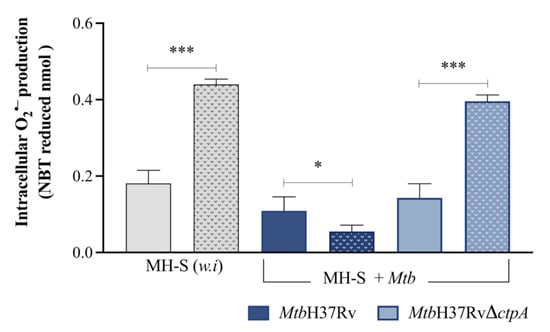
Figure 8.
Intracellular ROS production from Mtb-infected MH-S cells. Intracellular superoxide anion production by MH-S macrophages infected with MtbH37Rv or MtbH37RvΔctpA (MOI 1:3), in the absence (solid bar) or presence of the inducer PMA (900 ng/μL) (dotted bar), was measured using the modified colorimetric NBT assay [41,42]. Stimulation with PMA in uninfected (w.i) macrophages is the positive control of ROS production. As a negative control, the cells were incubated with 45 μg/mL SOD, but the levels obtained were below the detection limit. Asterisks indicate the two-tailed (unpaired) t-test comparison nmol NBT without PMA stimulation (* p < 0.05; *** p < 0.001).
3.5. MtbΔctpA Strain Attenuates Virulence in Mice
To evaluate the level of virulence in vivo of the ctpA deletion in Mtb, the survival, bacterial loads, and extension of tissue damage (percentage of lung area affected by pneumonia) were determined in BALB/c mice infected intratracheally with 2.40 × 105 CFU of MtbH37Rv or 2.07 × 10⁵ CFU MtbH37RvΔctpA [43,48,59]. Almost all of the animals infected with the ΔctpA strain survived during the whole experimental period (four months), with only one animal dying at 84 dpi. In contrast, mice infected with the parental strain started to die at 49 dpi and all the animals died at 65 dpi (Figure 9a). These results correlated well with those determined by CFUs of lung homogenates. The bacilli inoculum was similar for both strains; however, at 3 dpi, the number of CFU in the lungs of mice infected with the mutant MtbH37RvΔctpA was so low that it was below the detection limit (100 CFU/lung). In contrast, in the lungs of animals infected with the parental strain, approximately 3.93 × 105 CFU/lung was observed (Figure 9b). Furthermore, with respect to the bacilli inoculum, at 21 dpi, the bacterial load in the lungs of mice infected with the wild-type and mutant strain exhibited an increase of approximately 5.46-fold (1.31 × 106 vs. 2.40 × 105 CFU) and 1.44-fold (2.98 × 105 vs. 2.07 × 105 CFU), respectively. At 60 dpi, the bacterial load exhibited an additional increase of ~20-fold (2.59 × 107 CFU) and ~2.57-fold (7.65 × 105 CFU) in the tissues of animals infected with the wild-type and mutant strains, respectively (Figure 9b). By day 120, animals infected with the MtbΔctpA mutant strain exhibited a similar bacterial load (4.79 × 105), while no survival animals infected with the parental strain were available at this time point (Figure 9a).
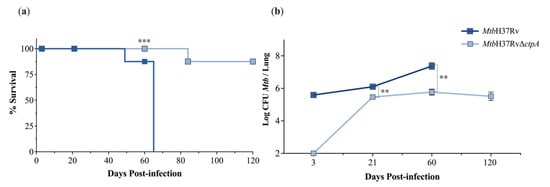
Figure 9.
Survival and lung bacillary burdens in BALB/c mice infected with either ctpA mutant or parental MtbH37Rv strains. (a) Almost all mice infected with mutant ctpA strain survived, while all animals died after 60 days of infection with the parental strain. (b) Groups of four animals were euthanized at the indicated days and lungs were used for the determination of live bacillary burdens by the quantification of CFU. At 3 dpi, the number of CFU in animals infected with the mutant strain was so low that it was below the limit of detection (2 Log/CFU). Asterisks indicate the significant difference by two-tailed unpaired t test (** p < 0.01; *** p < 0.001).
The quantification of pneumonia in animals infected with the parental strain at 60 dpi collectively revealed approximately 40% of lung consolidation (Figure 9b). The remaining tissue exhibited extensive regions of alveolitis and diffuse alveolar damage, as well as perivascular inflammatory infiltrate, predominantly composed by lymphocytes (Figure 10a and Figure S2). The extensive tissue damage and high bacilli burdens caused by the parental strain resulted in total mortality before reaching the final euthanasia time point on day 120 (Figure 9a). In contrast, the MtbΔctpA at 60 dpi produced few and small patches of pneumonia that collectively represented less than 10% of the total lung area (Figure 10 and Figure S3). The areas of alveolitis and the perivascular infiltrates were scarce. By day 120 post-infection, the pneumonic areas were well delimited and affected approximately 20% of the total lung surface, and the areas of alveolitis were minimal, as well as the perivascular infiltrates (Figure 10a and Figure S4). The reduction in histological damage and the low bacterial burden of the mutant strain in comparison with the parental strain indicates that CtpA plays a significant role in the virulence of mycobacteria (Figure 10).
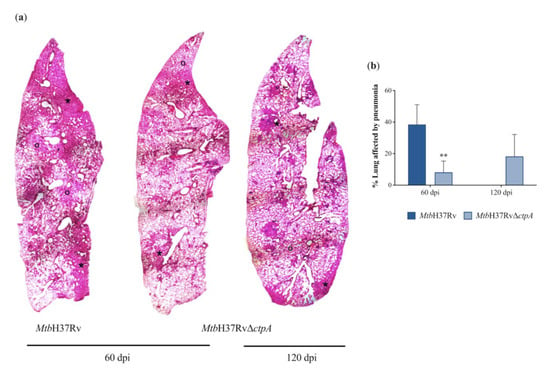
Figure 10.
Pneumonic areas in the lungs of Mtb-infected mice. (a) Representative low power micrographs of the lungs stained with hematoxylin and eosin (H&E) that show the extensive consolidated pneumonic (asterisks) and alveolitis (o) areas in the lungs of MtbH37Rv, while MtbΔctpA-infected mice at 60 and 120 days post-infection showed lesser tissue damage. (b) This was confirmed by the measurement of pneumonia by automated morphometry. Asterisks above the bars show a significant difference between wild-type and mutant strain (** p < 0.01). (Micrographs 25× magnification). Software Leica Application Suite v4.0.
4. Discussion
As has been previously reported, P1B-ATPase metal transporters have been recently identified as a relevant virulence factor for several intracellular pathogens, including Mtb [20,28,31,60]. The existence of multiple coding genes for these transporters with identical metal specificity and transport direction, suggest that they perform non-redundant roles during infection, which could be crucial for survival in hostile environmental conditions [20,27,28,29,61]. A recent study indicated that CtpA may have an alternative function distinct from copper detoxification. Thus, CtpA appears to be essential for the metalation of secreted proteins and the overcoming of redox stress [16]. Nevertheless, the precise role of this transporter during infection remains unknown. To determine the potential role of CtpA during Mtb-infection, the effect of the ctpA gene deletion on MtbH37Rv virulence was evaluated in a BALB/c mouse model of progressive pulmonary TB [59].
The results of this work confirm that the ΔctpA mutant strain is markedly attenuated, enabling the complete survival of infected animals following a four-month infection. Moreover, the bacillary loads in the lungs of infected animals were significantly lower than those observed in animals infected with the parental strain. As early as 3 dpi, the number of live bacilli in the infected lungs was below the limits of detection, clearly indicating that the ctpA deletion resulted in an early and deeply impaired Mtb growth proliferation, in contrast to mice infected with the wild-type MtbH37Rv parental strain, which produced progressive bacillary proliferation in the lungs [59]. Meanwhile, the high bacillary load in the MtbH37Rv-infected animals at 65 dpi (7.41 log10 CFU/lung), co-existed with extensive tissue damage and animal death. At 21 dpi and a later stage (120 dpi), the lungs of mutant-infected mice showed similar bacilli burdens (5.68 log10 CFU/lung). These findings suggest that the ctpA mutation plays a significant role during the initial stages of Mtb infection, which may be responsible for the diminished bacterial replication capacity and subsequent attenuation of MtbΔctpA. Consequently, the murine model of pulmonary TB indicates that the deletion of ctpA in Mtb may impact the early immune response, which is crucial for effective host control during the advanced stages of the disease [12]. These observations are consistent with our previous hypothesis that CtpA may play a role mainly in the early stages of the mycobacterial infection process [16]. Our previous report indicated that the transcription of ctpA was predominantly induced in MtbH37Ra cultures that were supplemented with concentrations of Cu2+ comparable to those found in phagosomes at 24 h post-infection with Mtb [16,45].
Given that the attenuation of the MtbΔctpA strain during the early phase of infection may have been caused by a reduction in its abilities to multiply and/or persist inside the host phagocytic cells, we conducted an examination of the intracellular proliferation of the ctpA-deficient mutant in resting and copper-activated alveolar macrophages. In this context, the attenuation exhibited by the MtbΔctpA mutant strain may be regulated by the presence of copper. The ΔctpA strain did not exhibit any significant growth restriction within resting macrophages. However, it was impaired within macrophages only in the presence of CuSO4 50 μM. Nevertheless, infection of MH-S macrophages with the MtbΔctpA mutant resulted in the transcription or production of proinflammatory cytokines and microbicidal components essential for the control of Mtb during natural infection, such as IL-1β, IL-12, TNF-α, iNOS, and NADPH oxidase [39,43]. The production of IL-1β and TNF-α was also influenced by the presence of copper during infection with the MtbΔctpA mutant strain. This may prevent the generation of a widespread chronic pro-inflammatory response. The absence or overproduction of certain proinflammatory cytokines, such as IL-1, during Mtb infection can result in disease susceptibility and increased host mortality [57,62,63]. Furthermore, the absence or low levels of TNF-α have been linked to a fatal progression of TB, largely due to a reduction in antimycobacterial responses of macrophages and impaired granuloma functionality [57]. An excess of TNF-α has been demonstrated to favor immunopathology by interfering with cell death processes and inducing an hyperinflammatory response [12,62,64]. Therefore, our observations suggest that, in conjunction with changes in copper homeostasis that occur as part of the control mechanisms of Mtb infection, a mutation in ctpA could result in diverse effects on the magnitude and type of immune response triggered against Mtb [12,53]. This may have contributed to the reduction in the immunopathology that occurs during a natural Mtb infection, thereby facilitating the attenuation of the mutant strain and the establishment of an effective immune response [9,12,57,65].
The pivotal and alternative roles of Mtb P1B-type ATPases in Mtb persistence are based on their interference with the mechanisms through which Mtb faces the redox-hostile conditions in the phagosome [20,28,29]. Considering these observations, our objective was to investigate whether CtpA plays a role in the mechanism by which Mtb responds to redox stress during infection. Thus, the MtbΔctpA mutant strain exhibited increased Nox2 gene expression at 3 and 6 dpi, in comparison to the wild-type strain. Moreover, if the reduction in NBT is a proportional indicator of intracellular O2•– concentration, and its decrease is associated with the ability of the bacillus to block oxygen-dependent microbicidal activity in infected cells [58], ctpA-deletion impairs the capacity of Mtb to scavenge ROS produced in infected macrophages. MtbΔctpA mutant is unable to neutralize ROS produced during infection of MH-S alveolar macrophages stimulated with PMA. This result, in conjunction with the previously reported sensitivity to the presence of redox agents in vitro [16], and the diminished capacity to evade ROS accumulation induced by external agents [66] in the absence of ctpA in Mtb (Figure S5), suggest that CtpA plays a role in the mechanisms that overcome redox stress under infection conditions. As previously reported, the copper transported by CtpA could be relevant for the metalation of the Mtb-cuproenzyme, MmcO [16]. Considering the role of MmcO in the scavenging of ROS produced by activated macrophages [34], it can be hypothesized that CtpA could participate in the detoxification of NADPH oxidase-derived ROS through the activation of redox enzymes that require the copper transported by CtpA for their activity [16].
New vaccine strategies should not only consider the ability to generate components of the host immune response with a protective role, such as INF-γ, TNF-α or CD4+ Th1 cells, but also contribute to the generation of a protective host response by overcoming Mtb immune evasion mechanisms, restoring the antimicrobial capacity of myeloid cells and their functional interactions with the adaptive immune system [12,65]. It has been proposed that protection at the level of phagocytic function may be achieved by enhancing autophagy, LC3-associated phagocytosis, phagosome-lysosome fusion, ROS production, nutritional immunity, optimal metabolic responses, or antigen presentation and communication with innate and adaptive lymphocytes [12,67]. It has been demonstrated that, by blocking the acquisition of NADPH oxidase and neutralizing host-derived ROS, Mtb impairs autophagy-related pathways (LC3) and limits TNF-mediated apoptosis [12,68,69,70]. Considering these findings, it can be postulated that CtpA plays a role in detoxifying ROS, thereby facilitating Mtb evasion mechanisms during infection. Consequently, its deletion may enhance the host cell’s redox stress response, including autophagy and programmed cell death, which could, in turn, promote the generation of protective immune responses, which would be the subject of further research.
5. Conclusions
In conclusion, the obtained results collectively reinforce interest in the potential of ctpA as an attenuation target in the development of an anti-TB vaccine. The attenuation of the MtbH37RvΔctpA strain in Mtb infection indicates the existence of a potential defect in the early phase of infection, which may be associated with a reduced capacity of Mtb to proliferate and persist within copper-activated phagocytic cells, accompanied by diminished responsiveness to oxidative stress. Therefore, the deletion of ctpA may induce additional control processes in phagocytic cells associated with ROS production, thereby interfering with the bacterial immune evasion mechanisms. Consequently, immunization with a live strain defective in ctpA could generate more efficient and prolonged immune responses for bacillus control and host protection.
Supplementary Materials
The following supporting information can be downloaded at: https://www.mdpi.com/article/10.3390/biomedicines13020439/s1, Figure S1: Oligonucleotide pair qPCR Amplification Efficiency Curves; Figure S2: Hematoxylin and eosin (H&E) stained lung tissues BALB/c mice infected with MtbH37Rv at 60 dpi; Figure S3: Hematoxylin and eosin (H&E) stained lung tissues BALB/c mice infected with MtbH37Rv∆ctpA at 60 dpi; Figure S4: Hematoxylin and eosin (H&E) stained lung tissues BALB/c mice infected with MtbH37Rv∆ctpA at 120 dpi; Figure S5: Effect of ctpA deletion on intracellular ROS generation in Mtb under stress conditions; Table S1: Bacterial strains, plasmids and primers used in this study; Table S2: qPCR-Primer sequences used in this study; Table S3: Efficiency and programs for relative quantification by RT-qPCR of genes expressed by Mtb-infected MH-S cells.
Author Contributions
Conceptualization, M.L.-R., J.B.-P., C.Y.S., D.M.-E. and R.H.-P.; formal analysis, M.L.-R., J.B.-P., C.Y.S., D.M.-E. and R.H.-P.; funding acquisition, C.Y.S. and R.H.-P.; investigation, M.L.-R.; methodology, M.L.-R., M.M.-H., D.M.-E. and J.B.-P.; supervision, C.Y.S., M.O. and R.H.-P.; writing—original draft, M.L.-R., J.B.-P., C.Y.S., D.M.-E. and R.H.-P.; writing—review & editing, M.L.-R., J.B.-P., M.M.-H., C.Y.S., D.M.-E. and R.H.-P. All authors have read and agreed to the published version of the manuscript.
Funding
This work was supported by the División de Investigación Bogotá (DIB)-Universidad Nacional de Colombia, grants 47274, 50299, 57532 and 60311, and Consejo Nacional de Ciencia y Tecnología (CONACyT)-Mexico, Contract Number: 223279. M.L.-R. was a fellow Asistente Docente de la Direccion Academica of Universidad Nacional de Colombia-Bogotá (2018–2021).
Institutional Review Board Statement
All of the protocols with animals (mouse model) were reviewed and approved by the Internal Committee for the Care and Use of Laboratory Animals (CICUAL) of the National Institute of Medical Sciences and Nutrition ‘‘Salvador Zubiran” in Mexico City (permit code PAT-2076-22-23-1) approved on 3 October 2022.
Informed Consent Statement
Not applicable.
Data Availability Statement
The data presented in this study are available on request from the corresponding author.
Acknowledgments
We thank José Ainsa from Universidad de Zaragoza for providing the pJV53 and pYUB854 plasmids. We want to thank Andres León-Torres for the construction of the pALT25 plasmid.
Conflicts of Interest
The authors declare no conflicts of interest.
References
- World Health Organization. Global Tuberculosis Report 2024; World Health Organization: Geneva, Switzerland, 2024; Licence: CC BY-NC-SA 3.0 IGO; ISBN 978-92-4-010153-1. [Google Scholar]
- Rezaei, N.; Hosseini, N.-S.; Saghazadeh, A. Introduction to Tuberculosis: Integrated Studies for a Complex Disease. In Tuberculosis: Integrated Studies for a Complex Disease; Rezaei, N., Ed.; Springer: Cham, Switzerland, 2023; Volume 11, pp. 1–16. [Google Scholar]
- Pérez-Martínez, D.; Mejía-Ponce, P.; Licona-Cassani, C.; de Igartua, E.; Bermúdez, G.; Viveros, D.; Zenteno-Cuevas, R. Drug Resistance in Tuberculosis: Mechanisms, Diagnosis, New Responses, and the Need for an Integrated Approach. In Tuberculosis: Integrated Studies for a Complex Disease; Rezaei, N., Ed.; Springer: Cham, Switzerland, 2023; Volume 11, pp. 331–359. [Google Scholar]
- Kuan, R.; Muskat, K.; Peters, B.; Lindestam Arlehamn, C.S. BCG Vaccine Efficacy, Immune Correlates of Protection and antigen-Specific T Cell Responses. J. Intern. Med. 2020, 288, 651–660. [Google Scholar] [CrossRef] [PubMed]
- Lange, C.; Aaby, P.; Behr, M.A.; Donald, P.R.; Kaufmann, S.H.E.; Netea, M.G.; Mandalakas, A.M. 100 Years of Mycobacterium Bovis Bacille Calmette-Guérin. Lancet Infect. Dis. 2021, 22, e2–e12. [Google Scholar] [CrossRef] [PubMed]
- Li, J.; Zhan, L.; Qin, C. The Double-Sided Effects of Mycobacterium Bovis Bacillus Calmette–Guérin Vaccine. NPJ Vaccines 2021, 6, 14. [Google Scholar] [CrossRef]
- Wang, H.; Wang, S.; Fang, R.; Li, X.; Xing, J.; Li, Z.; Song, N. Enhancing TB Vaccine Efficacy: Current Progress on Vaccines, Adjuvants and Immunization Strategies. Vaccines 2024, 12, 38. [Google Scholar] [CrossRef]
- Zhou, F.; Zhang, D. Recent Advance in the Development of Tuberculosis Vaccines in Clinical Trials and Virus-like Particle-Based Vaccine Candidates. Front. Immunol. 2023, 14, 1238649. [Google Scholar] [CrossRef]
- Zhuang, L.; Ye, Z.; Li, L.; Yang, L.; Gong, W. Next-Generation TB Vaccines: Progress, Challenges, and Prospects. Vaccines 2023, 11, 1304. [Google Scholar] [CrossRef]
- Hernández-Pando, R.; Shin, S.J.; Clark, S.; Casonato, S.; Becerril-Zambrano, M.; Kim, H.; Boldrin, F.; Mata-Espinoza, D.; Provvedi, R.; Arbues, A.; et al. Construction and Characterization of the Mycobacterium Tuberculosis SigE FadD26 Unmarked Double Mutant as a Vaccine Candidate. Infect. Immun. 2020, 88, e00496-19. [Google Scholar] [CrossRef]
- Maya-Hoyos, M.; Mata-Espinosa, D.; López-Torres, M.O.; Tovar-Vázquez, B.; Barrios-Payán, J.; León-Contreras, J.C.; Ocampo, M.; Hernández-Pando, R.; Soto, C.Y. The CtpF Gene Encoding a Calcium P-Type ATPase of the Plasma Membrane Contributes to Full Virulence of Mycobacterium Tuberculosis. Int. J. Mol. Sci. 2022, 23, 6015. [Google Scholar] [CrossRef]
- Chandra, P.; Grigsby, S.J.; Philips, J.A. Immune Evasion and Provocation by Mycobacterium Tuberculosis. Nat. Rev. Microbiol. 2022, 20, 750–766. [Google Scholar] [CrossRef]
- Yatime, L.; Buch-pedersen, M.J.; Musgaard, M.; Morth, J.P.; Winther, A.-M.L.; Pedersen, B.P.; Olesen, C.; Peter, J.A.; Vilsen, B.; Schiøtt, B.; et al. P-Type ATPases as Drug Targets: Tools for Medicine and Science. Biochim. Biophys. Acta 2009, 1787, 207–220. [Google Scholar] [CrossRef]
- León-Torres, A.; Novoa-Aponte, L.; Soto, C.Y. CtpA, a Putative Mycobacterium Tuberculosis P-Type ATPase, Is Stimulated by Copper (I) in the Mycobacterial Plasma Membrane. BioMetals 2015, 28, 713–724. [Google Scholar] [CrossRef] [PubMed]
- León-Torres, A.; Arango, E.; Castillo, E.; Soto, C.Y. CtpB Is a Plasma Membrane Copper (I) Transporting P-Type ATPase of Mycobacterium Tuberculosis. Biol. Res. 2020, 53, 1–13. [Google Scholar] [CrossRef] [PubMed]
- López-R, M.; Maya-Hoyos, M.; León-Torres, A.; Cruz-Cacais, A.; Castillo, E.; Soto, C.Y. The Copper P-Type ATPase CtpA Is Involved in the Response of Mycobacterium Tuberculosis to Redox Stress. Biochimie 2024, 221, 137–146. [Google Scholar] [CrossRef]
- López, M.; Quitian, L.-V.; Calderón, M.-N.; Soto, C.-Y. The P-Type ATPase CtpG Preferentially Transports Cd2+ across the Mycobacterium Tuberculosis Plasma Membrane. Arch. Microbiol. 2018, 200, 483–492. [Google Scholar] [CrossRef] [PubMed]
- Maya-Hoyos, M.; Rosales, C.; Novoa-Aponte, L.; Castillo, E.; Soto, C.Y. The P-Type ATPase CtpF Is a Plasma Membrane Transporter Mediating Calcium Efflux in Mycobacterium Tuberculosis Cells. Heliyon 2019, 5, e02852. [Google Scholar] [CrossRef] [PubMed]
- Novoa-Aponte, L.; Soto Ospina, C.Y. Mycobacterium Tuberculosis P-Type ATPases: Possible Targets for Drug or Vaccine Development. Biomed. Res. Int. 2014, 2014, 296986. [Google Scholar] [CrossRef]
- Raimunda, D.; Long, J.E.; Padilla-Benavides, T.; Sassetti, C.M.; Argüello, J.M. Differential Roles for the Co2+/Ni2+ Transporting ATPases, CtpD and CtpJ, in Mycobacterium Tuberculosis Virulence. Mol. Microbiol. 2014, 91, 185–197. [Google Scholar] [CrossRef]
- Torres, A.F.L. Respuesta de Las ATPasas Tipo P 1B a las Condiciones de Estrés en Mycobacterium Tuberculosis. Ph.D. Thesis, Ciencias-Bioquímica, Universidad Nacional de Colombia, Bogotá, Colombia, 2018. [Google Scholar]
- Novoa-Aponte, L.; León-Torres, A.; Patiño-Ruiz, M.; Cuesta-Bernal, J.; Salazar, L.M.; Landsman, D.; Mariño-Ramírez, L.; Soto, C.Y. In Silico Identification and Characterization of the Ion Transport Specificity for P-Type ATPases in the Mycobacterium Tuberculosis Complex. BMC Struct. Biol. 2012, 12, 25. [Google Scholar] [CrossRef]
- Novoa-Aponte, L.; Argüello, J.M. Unique Underlying Principles Shaping Copper Homeostasis Networks. J. Biol. Inorg. Chem. 2022, 27, 509–528. [Google Scholar] [CrossRef]
- Shi, X.; Darwin, K.H. Copper Homeostasis in Mycobacterium Tuberculosis. Metallomics 2015, 7, 929–934. [Google Scholar] [CrossRef]
- Soldati, T.; Neyrolles, O. Mycobacteria and the Intraphagosomal Environment: Take It With a Pinch of Salt(s)! Traffic 2012, 13, 1042–1052. [Google Scholar] [CrossRef] [PubMed]
- Stafford, S.L.; Bokil, N.J.; Achard, M.E.S.; Kapetanovic, R.; Schembri, M.A.; Mcewan, A.G.; Sweet, M.J. Metal Ions in Macrophage Antimicrobial Pathways: Emerging Roles for Zinc and Copper. Biosci. Rep. 2013, 33, 541–554. [Google Scholar] [CrossRef]
- González-Guerrero, M.; Raimunda, D.; Cheng, X.; Argüello, J.M. Distinct Functional Roles of Homologous Cu+ Efflux ATPases in Pseudomonas Aeruginosa. Mol. Microbiol. 2010, 78, 1246–1258. [Google Scholar] [CrossRef]
- Padilla-Benavides, T.; Long, J.E.; Raimunda, D.; Sassetti, C.M.; Argüello, J.M. A Novel P1B-Type Mn2+-Transporting ATPase Is Required for Secreted Protein Metallation in Mycobacteria. J. Biol. Chem. 2013, 288, 11334–11347. [Google Scholar] [CrossRef] [PubMed]
- Patel, S.J.; Padilla-Benavides, T.; Collins, J.M.; Argüello, J.M. Functional Diversity of Five Homologous Cu+-ATPases Present in Sinorhizobium Meliloti. Microbiology 2014, 160, 1237–1251. [Google Scholar] [CrossRef] [PubMed]
- Ward, S.K.; Hoye, E.A.; Talaat, A.M. The Global Responses of Mycobacterium Tuberculosis to Physiological Levels of Copper. J. Bacteriol. 2008, 190, 2939–2946. [Google Scholar] [CrossRef] [PubMed]
- Ward, S.K.; Abomoelak, B.; Hoye, E.A.; Steinberg, H.; Talaat, A.M. CtpV: A Putative Copper Exporter Required for Full Virulence of Mycobacterium Tuberculosis. Mol. Microbiol. 2010, 77, 1096–1110. [Google Scholar] [CrossRef]
- Kumar, M.; Khan, F.G.; Sharma, S.; Kumar, R.; Faujdar, J.; Sharma, R.; Chauhan, D.S.; Singh, R.; Magotra, S.K.; Khan, I.A. Identification of Mycobacterium Tuberculosis Genes Preferentially Expressed during Human Infection. Microb. Pathog. 2011, 50, 31–38. [Google Scholar] [CrossRef]
- Rowland, J.L.; Niederweis, M. A Multicopper Oxidase Is Required for Copper Resistance in Mycobacterium Tuberculosis. J. Bacteriol. 2013, 195, 3724–3733. [Google Scholar] [CrossRef]
- Kinkar, E.; Kinkar, A.; Saleh, M. The Multicopper Oxidase of Mycobacterium tuberculosis (MmcO) Exhibits Ferroxidase Activity and Scavenges Reactive Oxygen Species in Activated THP-1 Cells. Int. J. Med. Microbiol. 2019, 309, 151324. [Google Scholar] [CrossRef]
- van Kessel, J.C.; Hatfull, G.F. Recombineering in Mycobacterium Tuberculosis. Nat. Methods 2007, 4, 147–152. [Google Scholar] [CrossRef] [PubMed]
- Sun, J.; Zhang, X.; Broderick, M.; Fein, H. Measurement of Nitric Oxide Production in Biological Systems by Using Griess Reaction Assay. Sensors 2003, 3, 276–284. [Google Scholar] [CrossRef]
- Dai, X.; Mao, C.; Lan, X.; Chen, H.; Li, M.; Bai, J.; Deng, J.; Liang, Q.; Zhang, J.; Zhong, X.; et al. Acute Penicillium Marneffei Infection Stimulates Host M1/M2a Macrophages Polarization in BALB/C Mice. BMC Microbiol. 2017, 17, 177. [Google Scholar] [CrossRef] [PubMed]
- Helfinger, V.; Palfi, K.; Weigert, A.; Schröder, K. The NADPH Oxidase Nox4 Controls Macrophage Polarization in an NFκB-Dependent Manner. Oxid. Med. Cell Longev. 2019, 2019, 3264858. [Google Scholar] [CrossRef]
- Hernández-Pando, R.; Aguilar, L.D.; Smith, I.; Manganelli, R. Immunogenicity and Protection Induced by a Mycobacterium tuberculosis SigE Mutant in a BALB/c Mouse Model of Progressive Pulmonary Tuberculosis. Infect. Immun. 2010, 78, 3168–3176. [Google Scholar] [CrossRef]
- Pfaffl, M.W. A New Mathematical Model for Relative Quantification in Real-Time RT-PCR. Nucleic Acids Res. 2001, 29, 2002–2007. [Google Scholar] [CrossRef]
- Sim Choi, H.; Woo Kim, J.; Cha, Y.-N.; Kim, C. A Quantitative Nitroblue Tetrazolium Assay for Determining Intracellular Superoxide Anion Production in Phagocytic Cells. J. Immunoass. Immunochem. 2006, 27, 31–44. [Google Scholar] [CrossRef]
- Rook, G.A.W.; Steele, J.; Umar, S.; Dockrell, H.M. A Simple Method for the Solubilization of Reduced NBT, and Its Use as a Colorimetric Assay for Activation of Human Macrophages by y-Interferon. J. Immunol. Methods 1985, 82, 161–167. [Google Scholar] [CrossRef]
- Hernández-Pando, R.; Orozco, H.; Arriaga, E.K.; Sampieri, A.; Larriva-Sahd, J.; Madrid-Marina, V. Analysis of the Local Kinetics and Localization of Interleukin-1α, Tumour Necrosis Factor-α and Transforming Growth Factor-β, during the Course of Experimental Pulmonary Tuberculosis. Immunology 1997, 90, 607–617. [Google Scholar] [CrossRef]
- Bonilla, D.L.; Bhattacharya, A.; Sha, Y.; Xu, Y.; Xiang, Q.; Kan, A.; Jagannath, C.; Komatsu, M.; Eissa, N.T. Autophagy Regulates Phagocytosis by Modulating the Expression of Scavenger Receptors. Immunity 2013, 39, 537–547. [Google Scholar] [CrossRef]
- Wagner, D.; Maser, J.; Lai, B.; Cai, Z.; Barry III, C.E.; Höner zu Bentrup, K.; Russell, D.G.; Bermudez, L.E. Elemental Analysis of Mycobacterium Avium-, Mycobacterium tuberculosis-, and Mycobacterium Smegmatis-Containing Phagosomes Indicates Pathogen-Induced Microenvironments within the Host Cell’s Endosomal System. J. Immunol. 2005, 174, 1491–1500. [Google Scholar] [CrossRef] [PubMed]
- Achard, M.E.S.; Stafford, S.L.; Bokil, N.J.; Chartres, J.; Bernhardt, P.V.; Schembri, M.A.; Sweet, M.J.; McEwan, A.G. Copper Redistribution in Murine Macrophages in Response to Salmonella Infection. Biochem. J. 2012, 444, 51–57. [Google Scholar] [CrossRef] [PubMed]
- White, C.; Lee, J.; Kambe, T.; Fritsche, K.; Petris, M.J. A Role for the ATP7A Copper-Transporting ATPase in Macrophage Bactericidal Activity. J. Biol. Chem. 2009, 284, 33949–33956. [Google Scholar] [CrossRef]
- Hernández-Pando, R.; Aguilar, L.D.; Infante, E.; Cataldi, A.; Bigi, F.; Martin, C.; Gicquel, B. The Use of Mutant Mycobacteria as New Vaccines to Prevent Tuberculosis. Tuberculosis 2006, 86, 203–210. [Google Scholar] [CrossRef]
- Fontán, P.A.; Aris, V.; Alvarez, M.E.; Ghanny, S.; Cheng, J.; Soteropoulos, P.; Trevani, A.; Pine, R.; Smith, I. Mycobacterium tuberculosis Sigma Factor E Regulon Modulates the Host Inflammatory Response. J. Infect. Dis. 2008, 198, 877–885. [Google Scholar] [CrossRef][Green Version]
- Infante, E.; Aguilar, L.D.; Gicquel, B.; Hernandez Pando, R. Immunogenicity and Protective Efficacy of the Mycobacterium Tuberculosis FadD26 Mutant. Clin. Exp. Immunol. 2005, 141, 21–28. [Google Scholar] [CrossRef]
- Olsen, A.; Chen, Y.; Ji, Q.; Zhu, G.; De Silva, A.D.; Vilchèze, C.; Weisbrod, T.; Li, W.; Xu, J.; Larsen, M.; et al. Targeting Mycobacterium tuberculosis Tumor Necrosis Factor Alpha-Downregulating Genes for the Development of Antituberculous Vaccines. mBio 2016, 7, e01023-15. [Google Scholar] [CrossRef]
- Rousseau, C.; Winter, N.; Pivert, E.; Bordat, Y.; Neyrolles, O.; Avé, P.; Huerre, M.; Gicquel, B.; Jackson, M. Production of Phthiocerol Dimycocerosates Protects Mycobacterium Tuberculosis from the Cidal Activity of Reactive Nitrogen Intermediates Produced by Macrophages and Modulates the Early Immune Response to Infection. Cell Microbiol. 2004, 6, 277–287. [Google Scholar] [CrossRef]
- Díez-Tercero, L.; Delgado, L.M.; Bosch-Rué, E.; Perez, R.A. Evaluation of the Immunomodulatory Effects of Cobalt, Copper and Magnesium Ions in a pro Inflammatory Environment. Sci. Rep. 2021, 11, 11707. [Google Scholar] [CrossRef]
- Bedard, K.; Krause, K.-H. The NOX Family of ROS-Generating NADPH Oxidases: Physiology and Pathophysiology. Physiol. Rev. 2007, 87, 245–313. [Google Scholar] [CrossRef]
- Herb, M.; Schramm, M. Functions of ROS in Macrophages and Antimicrobial Immunity. Antioxidants 2021, 10, 313. [Google Scholar] [CrossRef] [PubMed]
- Macmicking, J.; Xie, Q.-W.; Hathan, C. Nitric Oxide and Macrophage Function. Annu. Rev. Immunol. 1997, 15, 323–350. [Google Scholar] [CrossRef] [PubMed]
- Ravesloot-Chávez, M.M.; Van Dis, E.; Stanley, S.A. The Innate Immune Response to Mycobacterium Tuberculosis Infection. Annu. Rev. Immunol. 2021, 39, 611–637. [Google Scholar] [CrossRef] [PubMed]
- Silva, I.D.; Jain, N.C. Phagocytic and Nitroblue Tetrazolium Reductive Properties of Bovine Neutrophils for Mammary Pathogens. J. Dairy. Sci. 1988, 71, 1625–1631. [Google Scholar] [CrossRef]
- Hernández-Pando, R.; Orozcoe, H.; Sampieri, A.; Pavon, L.; Velasquillo, C.; Larriva-Sahd, J.; Alcocer, J.M.; Madrid, M. V Correlation between the Kinetics of Th1/Th2 Cells and Pathology in a Murine Model of Experimental Pulmonary Tuberculosis. Immunology 1996, 89, 26–33. [Google Scholar]
- Botella, H.; Peyron, P.; Levillain, F.; Poincloux, R.; Poquet, Y.; Brandli, I.; Wang, C.; Tailleux, L.; Tilleul, S.; Charrire, G.M.; et al. Mycobacterial P1-Type ATPases Mediate Resistance to Zinc Poisoning in Human Macrophages. Cell Host Microbe 2011, 10, 248–259. [Google Scholar] [CrossRef]
- Raimunda, D.; González-Guerrero, M.; Leeber, B.W.; Argüello, J.M. The Transport Mechanism of Bacterial Cu+-ATPases: Distinct Efflux Rates Adapted to Different Function. BioMetals 2011, 24, 467–475. [Google Scholar] [CrossRef]
- Roca, F.J.; Whitworth, L.J.; Redmond, S.; Jones, A.A.; Ramakrishnan, L. TNF Induces Pathogenic Programmed Macrophage Necrosis in Tuberculosis through a Mitochondrial-Lysosomal-Endoplasmic Reticulum Circuit. Cell 2019, 178, 1344–1361. [Google Scholar] [CrossRef]
- Silvério, D.; Gonçalves, R.; Appelberg, R.; Saraiva, M. Advances on the Role and Applications of Interleukin-1 in Tuberculosis. mBio 2021, 12, e03134-21. [Google Scholar] [CrossRef]
- Roca, F.J.; Whitworth, L.J.; Prag, H.A.; Murphy, M.P.; Ramakrishnan, L. Tumor Necrosis Factor Induces Pathogenic Mitochondrial ROS in Tuberculosis through Reverse Electron Transport. Science 2022, 376, eabh2841. [Google Scholar] [CrossRef]
- Liu, X.; Li, H.; Li, S.; Yuan, J.; Pang, Y. Maintenance and Recall of Memory T Cell Populations against Tuberculosis: Implications for Vaccine Design. Front. Immunol. 2023, 14, 1100741. [Google Scholar] [CrossRef] [PubMed]
- Padwal, P.; Bandyopadhyaya, R.; Mehra, S. Biocompatible Citric Acid-Coated Iron Oxide Nanoparticles to Enhance the Activity of First-Line Anti-TB Drugs in Mycobacterium Smegmatis. J. Chem. Technol. Biotechnol. 2015, 90, 1773–1781. [Google Scholar] [CrossRef]
- Flores-Valdez, M.A.; Segura-Cerda, C.A.; Gaona-Bernal, J. Modulation of Autophagy as a Strategy for Development of New Vaccine Candidates against Tuberculosis. Mol. Immunol. 2018, 97, 16–19. [Google Scholar] [CrossRef] [PubMed]
- Köster, S.; Upadhyay, S.; Chandra, P.; Papavinasasundaram, K.; Yang, G.; Hassan, A.; Grigsby, S.J.; Mittal, E.; Park, H.S.; Jones, V.; et al. Mycobacterium Tuberculosis Is Protected from NADPH Oxidase and LC3-Associated Phagocytosis by the LCP Protein CpsA. Proc. Natl. Acad. Sci. USA 2017, 114, E8711–E8720. [Google Scholar] [CrossRef] [PubMed]
- Upadhyay, S.; Mittal, E.; Philips, J.A. Tuberculosis and the Art of Macrophage Manipulation. Pathog. Dis. 2018, 76, fty037. [Google Scholar] [CrossRef]
- Srivastava, S.; Battu, M.B.; Khan, M.Z.; Nandicoori, V.K.; Mukhopadhyay, S. Mycobacterium Tuberculosis PPE2 Protein Interacts with P67phox and Inhibits Reactive Oxygen Species Production. J. Immunol. 2019, 203, 1218–1229. [Google Scholar] [CrossRef]
Disclaimer/Publisher’s Note: The statements, opinions and data contained in all publications are solely those of the individual author(s) and contributor(s) and not of MDPI and/or the editor(s). MDPI and/or the editor(s) disclaim responsibility for any injury to people or property resulting from any ideas, methods, instructions or products referred to in the content. |
© 2025 by the authors. Licensee MDPI, Basel, Switzerland. This article is an open access article distributed under the terms and conditions of the Creative Commons Attribution (CC BY) license (https://creativecommons.org/licenses/by/4.0/).